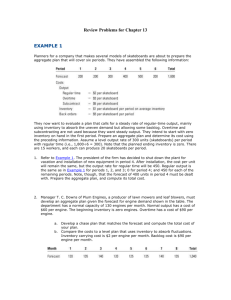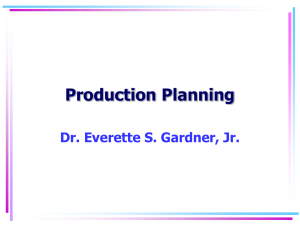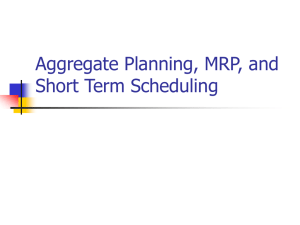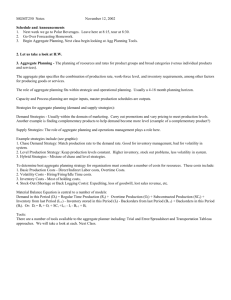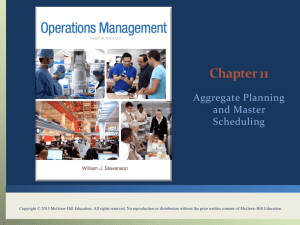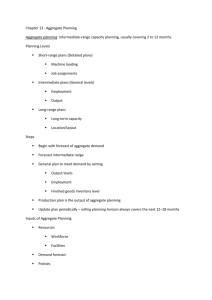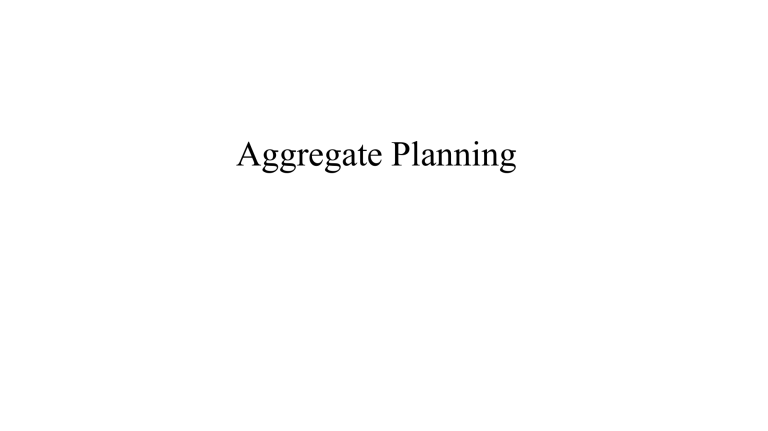
Aggregate Planning Planning Horizon Aggregate planning: Intermediate-range capacity planning, usually covering 2 to 12 months. Long range Short range Now Intermediate range 2 months 1 Year Overview of Planning Levels Short-range plans • Job assignments • Job sequencing • scheduling Intermediate plans • • • • • Employment level Output level Finished goods inventories Backorder Subcontracting Long-range plans • Long term capacity • Location / layout • Product design Aggregate Planning Inputs • Resources • Workforce • Facilities • Demand forecast • Policies • Subcontracting • Overtime • Inventory levels • Back orders • Costs • Inventory carrying • Back orders • Hiring/firing • Overtime Aggregate Planning Outputs • Total cost of a plan • Projected levels of inventory • Projected levels of output • Projected level of Employment • Projected level of Subcontracting • Projected level of backordering Objective of Aggregate Planning • The objective is to achieve rough equality of demand and capacity over the entire planning horizon. Aggregate Planning Strategies Proactive • Proactive strategies involve demand options: They attempt to alter demand so that it matches capacity. • Demand options include pricing and back orders Reactive • Reactive strategies involve capacity options: They attempt to alter capacity so that it matches demand. • Supply options include hiring/laying off workers, overtime, part-time or temporary workers, inventories, and subcontractors. Basic strategies for meeting uneven demand Basic strategy for meeting uneven demand 1. Level (maintain constant workforce level and output rate) Throughout the time constant production rate are maintained 2. Chase (match demand period by period) Only produce the amount that match the demand. If demand is higher increase capacity of production, and if demand lower decrease the capacity of production. 1. Level strategy 2. Chase strategy Understanding the steps of aggregate planning 1. Determine demand for each period (Aggregate demand). 2. Determine the capacities (regular time, overtime, subcontracting) for each period. 3. Identify the company policy (e.g., hours of regular time, hours of overtime, amount of holding inventory). 4. Determine unit cost for regular time, overtime, holding inventory, layoff, subcontracting. 5. Develop alternative plans and compute cost for each. 6. Select one that best satisfies the objective. Techniques for Aggregate Planning Trial-and-error techniques (Using worksheet/ spreadsheet) • In this we develop different types of combinations of decision variables • Alternative are evaluated in term of their overall cost. • The combination leads to minimum cost is selected. • Main demerit is that, a planner can evaluate only limited number of alternatives (no optimal solution) • For using trail-and-error, we need to compute output and associated costs (See Worksheet) Use following relationship to obtain the number of workers, amount of inventory, and cost of particular plan 1. The number of workers available in any period is calculated as follows: 2a. The amount of inventory at the end of given period is calculated as follows: 2b. The average inventory for a period is equal to 3. The cost of a particular plan for a given period can be determined by summing the appropriate costs: Q. Planners for a company that makes several models of skateboards are about to prepare the aggregate plan that will cover six periods. They have assembled the following information: • They now want to evaluate a plan that calls for a steady rate of regular-time output, mainly using inventory to absorb the uneven demand but allowing some backlog. • Overtime and subcontracting are not used because they want steady output. They intend to start with zero inventory on hand in the first period. Prepare an aggregate plan and determine its cost using the above information. Assume a level output rate of 300 units (skateboards) per period with regular time (i.e., 1,800/6). • Note that the planned ending inventory is zero. There are 15 workers, and each can produce 20 skateboards per period. This is an example of level strategy Note that the first two quantities (Forecast & Regular output) in each column are givens. The remaining quantities in table is determined working down each column, beginning with the first column. The costs are then computed based on the quantities in the previous table. The total cost for this plan is $4,700 Q. • They now want to evaluate a plan that calls for a steady rate of regular-time output, mainly using inventory to absorb the uneven demand but allowing some backlog. • They intend to start with zero inventory on hand in the first period. They have learned that one person is about to retire from the company. Rather than replace that person, they would like to stay with the smaller workforce and use overtime to make up for the lost output. The reduced regular-time output is 280 units per period. The maximum amount of overtime output per period is 40 units. • Prepare an aggregate plan and determine its cost using the above information. Note that the planned ending inventory is zero. This is an example of level strategy Note that the first two quantities (Forecast, Regular output & overtime output) in each column are givens. The remaining quantities in table is determined working down each column, beginning with the first column. The costs are then computed based on the quantities in the previous table. The total cost for this plan is $4,640
